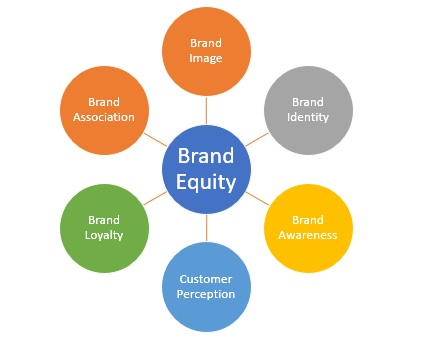- Business Concepts ›
- Marketing and Strategy ›
- Brand Equity
Brand Equity
Definition, Importance, Steps, Components & Example
This article covers meaning & overview of Brand Equity from marketing perspective.
What is meant by Brand Equity?
Brand Equity is a qualitative measure of the brand’s positive recognition or goodwill in the minds of the consumers considering the brand as an independent entity. Brand Equity is the tangible and intangible worth of a brand. The degree of premium that a brand can charge on its offering is a direct measure of the equity it possesses with its customers. Brand Equity is kind of power that the brand has over its competitors or the generic brands and is developed over time. It represents the overall value of the brand in the market.
Brand equity can be said to be coming from the aggregate worth of the following constituents in the minds of its consumers:
Importance of Brand Equity
Brand Equity is quite important in the fact that it helps one brand gain importance and additional revenue as when compared with the competitor. Brand Equity is a complex parameter which takes into account a lot of parameters like brand image, brand identity, brand awareness, brand loyalty, brand association etc. It is mainly subjective and qualitative but can be represented quantitatively.
Brand Equity is driven by marketing strategy & efforts over the years and consistency which results in customer perception and brand knowledge which may be positive or negative. Positive perception would result in increase in brand equity.
Effectively communicating the product benefits to the customers helps in brand building. Companies spend huge sums of money in advertising using integrated marketing communications (IMC) channels to promotes its goods & services.
Elements & Components of Brand Equity
Brand equity is a function of several other qualitative parameters which a customer can associate with a brand.
Some of the main components or elements of brand equity are as follows:
1.Brand Image
The image which is formed in customer's mind. Brand image is the most important parameter when it comes to creating brand equity.
2.Brand Identity
The image what the company is trying to form. Brand identity is created by the company to try to form positive brand image but it depends on how customers perceive.
3.Brand Awareness
Awareness is what is the level of awareness about a brand on products and services. Awareness should be high for good brand equity.
4.Brand Loyalty
How loyal is customer to the brand and will buy the products again even if options are there.
High brand switching can lead to less brand equity.
5.Brand Association
Does the customer associate brand to a positive attributes or not? Sometimes association something existing like event or celebrity can contribute to brand equity.
6.Customer Perception
What is the overall perception and experience of the customer related to the brand?
Since brand equity gives a qualitative outlook, it is quite complicated to define it through numbers or a value.

Steps to Calculate & Measure Brand Equity
Brand equity is a subjective concept based on customer & market perception. Measuring brand equity can be done by both qualitative research as well as quantitative research. Brand Equity can be measured on the basis of three important parameters which are:
1.Consumer Metrics
This measure of brand equity focuses on evaluating brands & products on the basis of factors like customer perception, attitude, belief, brand association etc.
2.Financial Metrics
Financial factors like revenue, profits, cost of new acquisition, growth, market share etc. help in measuring brand equity.
3.Strength Metrics
The strength of the brand in terms of brand recall, brand awareness, brand loyalty etc. are used in the measurement of brand equity.
All the above data can be collected by marketers using consumer research where customers can be given surveys or questionnaires to have their feedback. Qualitative feedback can be open-ended and other factors can be given weights which can help in the calculation of overall brand equity. Creating brand equity is a gradual process & takes years of efforts in establishing a particular brand image or perception in the mind of the consumer.
Example of Brand Equity
Some examples of brand equity are as follows. Consumers pay more for a Garnier beauty product than another local product. A brand can also have negative equity in cases where it does not fit well with its consumers. As an example, Tata Nano users reported some fire incidents with the product which led to its negative equity for a while.
Since brand equity is based on several parameters like brand image, brand identity, customer perception etc., it is primarily a qualitative parameter for a brand or company.
Hence, this concludes the definition of Brand Equity along with its overview.
This article has been researched & authored by the Business Concepts Team which comprises of MBA students, management professionals, and industry experts. It has been reviewed & published by the MBA Skool Team. The content on MBA Skool has been created for educational & academic purpose only.
Browse the definition and meaning of more similar terms. The Management Dictionary covers over 1800 business concepts from 5 categories.
Continue Reading:
What is MBA Skool?About Us
MBA Skool is a Knowledge Resource for Management Students, Aspirants & Professionals.
Business Courses
Quizzes & Skills
Quizzes test your expertise in business and Skill tests evaluate your management traits
Related Content
All Business Sections
Write for Us